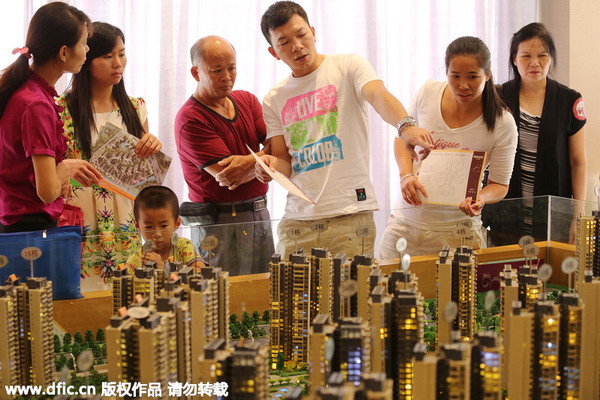 |
|
Chinese homebuyers look at models of residential apartment buildings during a real estate fair in Guangzhou city, South China's Guangdong province, Oct 12, 2014. [Photo / IC] |
Where will China's property market head after one-year cooling and later policy loosening for half a year? Will the market stop falling and start to pick up as expected?
From the statistics gathered in the first two months this year, the property market is unlikely to stop falling, let alone rebounding. It's hard to change an "inflection point" (a trend from upward to downward in this case) as long as it has formed. The adjustment in the real estate sector is an important part of China's overall economic restructuring.
The adjustment in China's economy since 2008 was divided into two phases. In the first one, export growth slowed down and stayed within "a normal growth range" amid the change of the external environment. Its growth, once much faster than that of GDP, dropped to a pace on a par with or even slightly below the economic expansion rate, bringing down the country's GDP growth to around 8 percent from over 10 percent.
The second phase is a shift to a growth model driven by domestic consumption instead of investment - a "new normal" that centers on real estate adjustments. This will lead to further economic slowdown to 6-7 percent. During this period, investment growth, like that of exports, will drop steadily to slightly lower than the GDP growth.
Property adjustment is just getting started, and we estimate the process will last for at least five to six years. After a fast expansion for 15 years, a low run for five to six years was fully justified by the long-term adjustment rule, and no policies can alter this trend.
Statistics show that the downward trend of the real estate market continued. Although the cooling speed slowed in recent months, the downward trend of the market has yet to change. In the first two months, investment in the sector posted an increase of 10.4 percent from a year earlier, down 0.1 percentage point from that of 2014.
A regional discrepancy is quite clear: the eastern area witnessed a rebound while central and western parts saw further slowdown. Housing investment jumped 11.4 percent year-on-year in the coastal area, or 1 percentage point higher than in 2014, but only 6.7 percent in the central and 11.1 percent in the western - a drop of 1.8 and 1.7 percentage points respectively from the average rate of 2014.
Investment growth, especially in the coastal area, seems to have sent us a signal that the housing market is turning stable. But the view will be totally different when we see it from the data of home sales - by floor areas and by volume.
Instead of a rebound, the property market even deteriorated. In January and February, commodity property sales by floor areas slumped by 16.3 percent year-on-year, down 16.2 percentage points than the same period last year and 8.7 percentage points than in 2014. The slump of residential housing sales was even bigger – by 17.8 percent. It's the same scenario in East China - with an accelerated decline of home sales.
Data related to the growth in supply and demand show an asymmetric feature in the process of property adjustments: The drop of investment growth slows whereas the slump of sales accelerates. What does it mean for the housing market?
Behind such an asymmetry, as I see it, hides a huge risk. Real estate demand continues to fall, but the developers refuse to act correspondingly. It's against the market rules. But why do they keep supplying amid such a weak demand? That's a question we need to ponder on.
